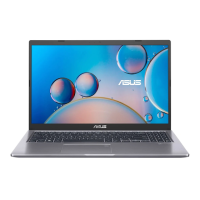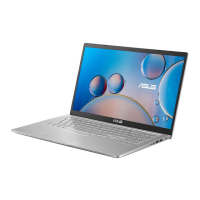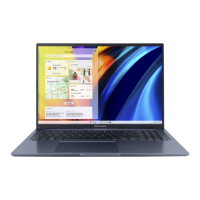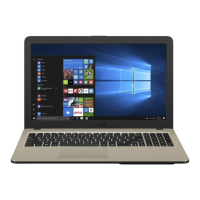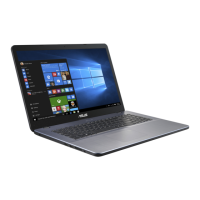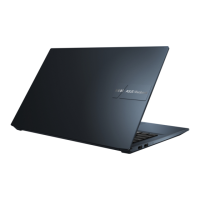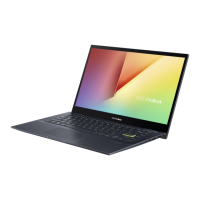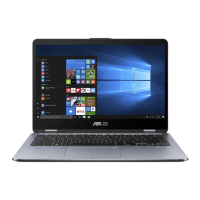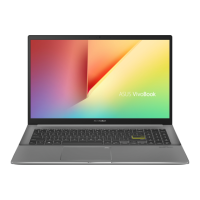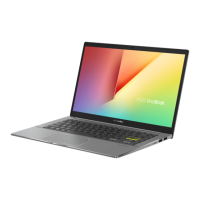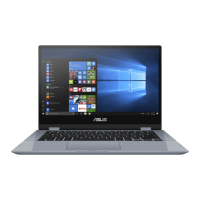Do you have a question about the Asus VivoBook 14 and is the answer not in the manual?
Details restrictions on manual reproduction and ASUS's copyright.
Outlines ASUS's liability limits for damages, excluding certain types of loss.
Directs users to the ASUS support website for assistance.
Details the hardware components of your Notebook PC.
Explains how to use the different parts of your Notebook PC.
Provides an overview of using Windows® 10 on your Notebook PC.
Explains the use of bold and italic text for menu items and references.
Illustrates icons used to represent touchpad and keyboard actions.
Covers ambient temperature limits, heat management, and avoiding damaged accessories.
Provides instructions for cleaning the Notebook PC using specific materials.
Lists items and conditions to avoid, such as liquids, dust, and gas leaks.
Instructs users not to dispose of the PC or battery in municipal waste.
Specifies that batteries should not be thrown in municipal waste.
Details the components and features visible on the top surface of the Notebook PC.
Explains the function of air vents in facilitating cool air intake and warm air expulsion.
Describes the built-in audio speakers for sound output, noting they are software-controlled.
Explains the purpose of status indicators, including the battery charge indicator.
Details the DC input port for power and the HDMI port for multimedia connection.
Provides steps to connect the power adapter and charge the notebook for initial use.
Instructions on how to lift and open the notebook's display panel.
Explains how to use the power button to turn the PC on/off or manage sleep/hibernate modes.
Details how to move the pointer on screen using various sliding gestures on the touchpad.
Describes using single-finger tap for selection and double-tap for launching.
Explains how to move items by tapping, sliding, and releasing on the touchpad.
Details how to perform left-click and right-click actions using the touchpad.
Explains how to simulate a right-click by tapping with two fingers on the touchpad.
Describes two-finger gestures for scrolling and zooming in/out on the touchpad.
Explains how to invoke Cortana by tapping the touchpad with three fingers.
Details invoking the Action Center by tapping with four fingers on the touchpad.
Guides on adjusting touchpad sensitivity and preferences in Windows settings.
Explains how to toggle between number keys and touchpad, adjust brightness, and launch Calculator.
Lists and describes the functions of various hotkeys for speaker, brightness, touchpad, and display.
Explains how to enable/disable function keys and access hotkeys.
Describes the function of Windows keys for launching the Start menu and context menus.
Guides through the initial setup process, including region, language, and settings.
Explains the Start menu as a gateway to programs, apps, and settings.
Lists common tasks like launching apps, adjusting settings, and shutting down.
Details methods to open the Start menu using mouse or keyboard.
Explains how to launch installed programs via the Start menu using mouse or keyboard.
Describes Windows® apps pinned in the Start menu's right pane for easy access.
Instructions on launching apps via the Start menu using mouse or keyboard.
Guides on moving, resizing, unpinning, or pinning apps within the Start menu and taskbar.
Details how to resize app tiles in the Start menu.
Explains how to remove apps from the Start menu or taskbar.
Instructions on pinning apps to the taskbar for quick access.
Guides on adding apps to the Start menu from the 'All apps' list.
Details methods to open Task View using the taskbar icon or keyboard shortcut.
Explains how the Snap feature displays apps side-by-side for efficient multitasking.
Describes hotspots for dragging and dropping apps to snap them into place.
Provides steps to snap apps using the drag-and-drop method with the mouse.
Details how to snap apps using keyboard shortcuts and arrow keys.
Explains how to open the Action Center via the taskbar icon or keyboard shortcut.
Lists keyboard shortcuts for launching Start menu, Action Center, desktop, File Explorer, and Settings.
Details shortcuts for Search, Project panel, Run window, Ease of Access, and context menus.
Provides steps to connect to a Wi-Fi network via the taskbar icon.
Guides on pairing the Notebook PC with other Bluetooth-enabled devices for data transfer.
Explains how to enable and disable Airplane mode using the Action Center.
Details methods for a normal shutdown via the Start menu or login screen.
Explains how to force shutdown the PC by holding the power button.
Provides methods to put the Notebook PC into sleep mode via Start menu or power button.
Explains POST as diagnostic tests run during startup.
Describes the BIOS for system hardware settings and when to change defaults.
Details two methods to enter BIOS settings: via F2 key or through Windows Advanced startup.
Advises backing up data and noting settings before performing recovery.
Describes recovery options like 'Keep my files' and 'Remove everything'.
Guides to launch recovery options through Windows Settings > Update & security.
Offers tips on updating, using anti-virus, proper shutdown, and backups.
Addresses issues like black dots and uneven color/brightness on the display panel.
Provides suggestions to improve notebook battery life, like adjusting brightness and disabling Wi-Fi.
Troubleshoots problems with the battery charge indicator and the touchpad.
Addresses no sound from speakers and lost/non-working power adapters.
Explains how to resolve issues with the cursor moving unintentionally while typing.
Troubleshoots 'power indicator lights up but nothing appears' and 'remove disks' messages.
Addresses slow boot times and operating system lags by suggesting application removal.
Provides steps to troubleshoot when the Notebook PC fails to boot up.
Explains how to resume from sleep mode and troubleshoot battery depletion.
Explains DVD region coding and copyright laws affecting playback compatibility.
Lists countries and territories included in DVD region definitions 1 through 6.
Defines regions A, B, and C for Blu-ray disc playback.
Details compliance with JATE, FCC, and CTR21 standards for the internal modem.
Explains the CTR 21 regulation for connecting terminal equipment to public switched telephone networks.
States how the equipment is designed to work with networks and potential inter-working difficulties.
Defines types of equipment eligible under CTR 21, excluding those focused on speech quality.
Details compliance with FCC Rules Part 15 regarding harmful interference and operation conditions.
Warns about changes to equipment and maintaining compliance with FCC radiation exposure limits.
Explains the purpose of coating for electrical insulation and safety.
States compliance with Innovation, Science and Economic Development Canada RSS standards.
Provides the French version of the ISED compliance statement.
Details safety precautions for telecommunications equipment connection and modem usage.
Covers safety warnings for lithium batteries, including disposal and adapter usage.
Specifies requirements for power cords used with products rated up to 6A.
Provides notes for CATV system installers regarding grounding and bonding.
Advises listening at moderate volume levels to prevent hearing damage.
Presents caution statements regarding lithium battery explosion risks in multiple languages.
Provides the CTR 21 approval statement for notebooks with built-in modems in English and other languages.
States ASUS's commitment to environmental regulations and green design.
Details compliance with EU REACH and RoHS directives regarding chemical substances.
Covers Japan JIS-C-0950 and India RoHS requirements for material declarations.
Specifies compliance with Vietnam Circular 30/2011/TT-BCT for products sold in Vietnam.
Outlines ASUS's commitment to responsible recycling and takeback services.
Provides contact information for rechargeable battery recycling services in North America.
Explains the EU framework for ecodesign requirements for energy-related products.
Details the ENERGY STAR program and its benefits for energy-efficient products.
Provides information on public disclosure for EPEAT registered products.
Warns about risks of battery replacement and proper recycling.
States compliance with IMDA Standards for ASUS products in Singapore.
Declares compliance with EU Directive 2014/53/EU and provides a link to the full text.
Lists countries where WiFi operation in the 5150-5350 MHz band is restricted to indoor use.
Details restrictions on manual reproduction and ASUS's copyright.
Outlines ASUS's liability limits for damages, excluding certain types of loss.
Directs users to the ASUS support website for assistance.
Details the hardware components of your Notebook PC.
Explains how to use the different parts of your Notebook PC.
Provides an overview of using Windows® 10 on your Notebook PC.
Explains the use of bold and italic text for menu items and references.
Illustrates icons used to represent touchpad and keyboard actions.
Covers ambient temperature limits, heat management, and avoiding damaged accessories.
Provides instructions for cleaning the Notebook PC using specific materials.
Lists items and conditions to avoid, such as liquids, dust, and gas leaks.
Instructs users not to dispose of the PC or battery in municipal waste.
Specifies that batteries should not be thrown in municipal waste.
Details the components and features visible on the top surface of the Notebook PC.
Explains the function of air vents in facilitating cool air intake and warm air expulsion.
Describes the built-in audio speakers for sound output, noting they are software-controlled.
Explains the purpose of status indicators, including the battery charge indicator.
Details the DC input port for power and the HDMI port for multimedia connection.
Provides steps to connect the power adapter and charge the notebook for initial use.
Instructions on how to lift and open the notebook's display panel.
Explains how to use the power button to turn the PC on/off or manage sleep/hibernate modes.
Details how to move the pointer on screen using various sliding gestures on the touchpad.
Describes using single-finger tap for selection and double-tap for launching.
Explains how to move items by tapping, sliding, and releasing on the touchpad.
Details how to perform left-click and right-click actions using the touchpad.
Explains how to simulate a right-click by tapping with two fingers on the touchpad.
Describes two-finger gestures for scrolling and zooming in/out on the touchpad.
Explains how to invoke Cortana by tapping the touchpad with three fingers.
Details invoking the Action Center by tapping with four fingers on the touchpad.
Guides on adjusting touchpad sensitivity and preferences in Windows settings.
Explains how to toggle between number keys and touchpad, adjust brightness, and launch Calculator.
Lists and describes the functions of various hotkeys for speaker, brightness, touchpad, and display.
Explains how to enable/disable function keys and access hotkeys.
Describes the function of Windows keys for launching the Start menu and context menus.
Guides through the initial setup process, including region, language, and settings.
Explains the Start menu as a gateway to programs, apps, and settings.
Lists common tasks like launching apps, adjusting settings, and shutting down.
Details methods to open the Start menu using mouse or keyboard.
Explains how to launch installed programs via the Start menu using mouse or keyboard.
Describes Windows® apps pinned in the Start menu's right pane for easy access.
Instructions on launching apps via the Start menu using mouse or keyboard.
Guides on moving, resizing, unpinning, or pinning apps within the Start menu and taskbar.
Details how to resize app tiles in the Start menu.
Explains how to remove apps from the Start menu or taskbar.
Instructions on pinning apps to the taskbar for quick access.
Guides on adding apps to the Start menu from the 'All apps' list.
Details methods to open Task View using the taskbar icon or keyboard shortcut.
Explains how the Snap feature displays apps side-by-side for efficient multitasking.
Describes hotspots for dragging and dropping apps to snap them into place.
Provides steps to snap apps using the drag-and-drop method with the mouse.
Details how to snap apps using keyboard shortcuts and arrow keys.
Explains how to open the Action Center via the taskbar icon or keyboard shortcut.
Lists keyboard shortcuts for launching Start menu, Action Center, desktop, File Explorer, and Settings.
Details shortcuts for Search, Project panel, Run window, Ease of Access, and context menus.
Provides steps to connect to a Wi-Fi network via the taskbar icon.
Guides on pairing the Notebook PC with other Bluetooth-enabled devices for data transfer.
Explains how to enable and disable Airplane mode using the Action Center.
Details methods for a normal shutdown via the Start menu or login screen.
Explains how to force shutdown the PC by holding the power button.
Provides methods to put the Notebook PC into sleep mode via Start menu or power button.
Explains POST as diagnostic tests run during startup.
Describes the BIOS for system hardware settings and when to change defaults.
Details two methods to enter BIOS settings: via F2 key or through Windows Advanced startup.
Advises backing up data and noting settings before performing recovery.
Describes recovery options like 'Keep my files' and 'Remove everything'.
Guides to launch recovery options through Windows Settings > Update & security.
Offers tips on updating, using anti-virus, proper shutdown, and backups.
Addresses issues like black dots and uneven color/brightness on the display panel.
Provides suggestions to improve notebook battery life, like adjusting brightness and disabling Wi-Fi.
Troubleshoots problems with the battery charge indicator and the touchpad.
Addresses no sound from speakers and lost/non-working power adapters.
Explains how to resolve issues with the cursor moving unintentionally while typing.
Troubleshoots 'power indicator lights up but nothing appears' and 'remove disks' messages.
Addresses slow boot times and operating system lags by suggesting application removal.
Provides steps to troubleshoot when the Notebook PC fails to boot up.
Explains how to resume from sleep mode and troubleshoot battery depletion.
Explains DVD region coding and copyright laws affecting playback compatibility.
Lists countries and territories included in DVD region definitions 1 through 6.
Defines regions A, B, and C for Blu-ray disc playback.
Details compliance with JATE, FCC, and CTR21 standards for the internal modem.
Explains the CTR 21 regulation for connecting terminal equipment to public switched telephone networks.
States how the equipment is designed to work with networks and potential inter-working difficulties.
Defines types of equipment eligible under CTR 21, excluding those focused on speech quality.
Details compliance with FCC Rules Part 15 regarding harmful interference and operation conditions.
Warns about changes to equipment and maintaining compliance with FCC radiation exposure limits.
Explains the purpose of coating for electrical insulation and safety.
States compliance with Innovation, Science and Economic Development Canada RSS standards.
Provides the French version of the ISED compliance statement.
Details safety precautions for telecommunications equipment connection and modem usage.
Covers safety warnings for lithium batteries, including disposal and adapter usage.
Specifies requirements for power cords used with products rated up to 6A.
Provides notes for CATV system installers regarding grounding and bonding.
Advises listening at moderate volume levels to prevent hearing damage.
Presents caution statements regarding lithium battery explosion risks in multiple languages.
Provides the CTR 21 approval statement for notebooks with built-in modems in English and other languages.
States ASUS's commitment to environmental regulations and green design.
Details compliance with EU REACH and RoHS directives regarding chemical substances.
Covers Japan JIS-C-0950 and India RoHS requirements for material declarations.
Specifies compliance with Vietnam Circular 30/2011/TT-BCT for products sold in Vietnam.
Outlines ASUS's commitment to responsible recycling and takeback services.
Provides contact information for rechargeable battery recycling services in North America.
Explains the EU framework for ecodesign requirements for energy-related products.
Details the ENERGY STAR program and its benefits for energy-efficient products.
Provides information on public disclosure for EPEAT registered products.
Warns about risks of battery replacement and proper recycling.
States compliance with IMDA Standards for ASUS products in Singapore.
Declares compliance with EU Directive 2014/53/EU and provides a link to the full text.
Lists countries where WiFi operation in the 5150-5350 MHz band is restricted to indoor use.
| Display diagonal | 14 \ |
|---|---|
| Display brightness | 250 cd/m² |
| Native aspect ratio | 16:9 |
| Processor cache | 4 MB |
| Processor cores | 2 |
| Processor model | N4020 |
| Processor family | Intel® Celeron® N |
| Processor frequency | 2.8 GHz |
| Processor manufacturer | Intel |
| On-board graphics card | Yes |
| Discrete graphics card model | Not available |
| On-board graphics card model | Intel® UHD Graphics 600 |
| Internal memory | 4 GB |
| Memory form factor | On-board |
| Internal memory type | DDR4-SDRAM |
| SSD capacity | The Solid State Drive's storage capacity in Gigabytes. |
| SSD interface | PCI Express |
| Storage media | SSD |
| Total storage capacity | 128 GB |
| Number of SSDs installed | 1 |
| HDMI version | 1.4 |
| USB 2.0 ports quantity | USB 2.0 ports have a data transmission speed of 480 Mbps, and are backwards compatible with USB 1.1 ports. You can connect all kinds of peripheral devices to them. |
| USB 3.2 Gen 2 (3.1 Gen 2) Type-A ports quantity | 0 |
| Wi-Fi standards | 802.11a, 802.11b, 802.11g, Wi-Fi 4 (802.11n), Wi-Fi 5 (802.11ac) |
| Bluetooth version | 4.1 |
| Top Wi-Fi standard | Wi-Fi 5 (802.11ac) |
| Audio system | SonicMaster |
| Battery capacity | 42 Wh |
| Number of battery cells | 3 |
| AC adapter power | 33 W |
| AC adapter frequency | 50 - 60 Hz |
| AC adapter input voltage | 100 - 240 V |
| AC adapter output current | 1.75 A |
| AC adapter output voltage | 19 V |
| Password protection type | BIOS, User |
| Trial software | McAfee LiveSafe, Microsoft 365 Personal |
| Operating system installed | Windows 11 Home in S mode |
| Color name | 1B-Peacock Blue |
| Form factor | Clamshell |
| Product type | Laptop |
| Product color | Blue |
| Pointing device | Touchpad |
| Depth | 217 mm |
|---|---|
| Width | 325 mm |
| Height | - mm |
| Weight | 1300 g |
| Height (rear) | 18.4 mm |
| Height (front) | 18 mm |
